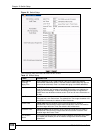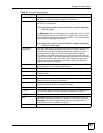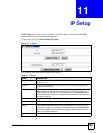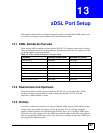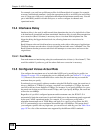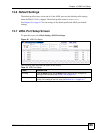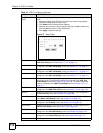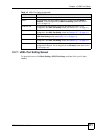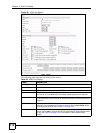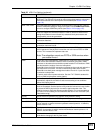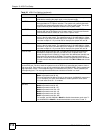
Chapter 13 xDSL Port Setup
IES-612-51A User’s Guide
108
For example, you could set up different profiles for different kinds of accounts (for example,
economy, standard and premium). Assign the appropriate profile to an ADSL port and it takes
care of a large part of the port’s configuration maximum and minimum transfer rates. You still
get to individually enable or disable each port, as well as configure its channels and
operational mode.
13.4 Interleave Delay
Interleave delay is the wait (in milliseconds) that determines the size of a single block of data
to be interleaved (assembled) and then transmitted. Interleave delay is used when transmission
error correction (Reed- Solomon) is necessary due to a less than ideal telephone line. The
bigger the delay, the bigger the data block size, allowing better error correction to be
performed.
Reed-Solomon codes are block-based error correcting codes with a wide range of applications.
The Reed-Solomon encoder takes a block of digital data and adds extra "redundant" bits. The
Reed-Solomon decoder processes each block and attempts to correct errors and recover the
original data.
13.4.1 Fast Mode
Fast mode means no interleaving takes place and transmission is faster (a “fast channel”). This
would be suitable if you have a good line where little error correction is necessary.
13.5 Configured Versus Actual Rate
You configure the maximum rate of an individual ADSL port by modifying its profile (see
Chapter 14 on page 125) or assigning the port to a different profile (see Section 13.7.1 on page
111). However, due to noise and other factors on the line, the actual rate may not reach the
maximum that you specify.
Even though you can specify arbitrary numbers using the Edit Profile screen, the actual rate is
always a multiple of 32 Kbps. If you enter a rate that is not a multiple of 32 Kbps, the actual
rate will be the next lower multiple of 32Kbps. For instance, if you specify 60 Kbps for a port,
the actual rate for that port will not exceed 32 Kbps, and if you specify 66 Kbps, the actual rate
will not be over 64Kbps.
Regardless of a profile’s configured upstream and downstream rates, the IES-612-51A
automatically limits the actual rates for each individual port to the maximum speeds supported
by the port’s ADSL operational mode. For example, if you configure a profile with a
maximum downstream rate of 25000 Kbps, and apply it to a port set to use G.dmt, the IES-
612-51A automatically uses a maximum downstream rate of 8160 Kbps. This means that if
you configure a profile with very high rates, you can still use it with any port. See Table 18 on
page 107 for a list of the maximum rates supported by the different ADSL standards.



